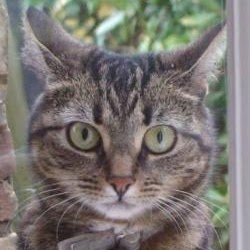Jun Saito
age ~50
from Seattle, WA
Jun Saito Phones & Addresses
- Seattle, WA
- Burbank, CA
- 640 American Ave, King of Prussia, PA 19406
- Aiea, HI
- 2344 Kapiolani Blvd, Honolulu, HI 96826 • 808 943-8775
- San Francisco, CA
- San Mateo, CA
- Kng Of Prussa, PA
- 98-402 Koauka Loop APT 1912, Aiea, HI 96701
Us Patents
-
Contact-Aware Retargeting Of Motion
view source -
US Patent:20230037339, Feb 9, 2023
-
Filed:Jul 26, 2021
-
Appl. No.:17/385559
-
Inventors:- San Jose CA, US
Jun Saito - Seattle WA, US
Jimei Yang - Mountain View CA, US
Duygu Ceylan Aksit - London, GB
Aaron Hertzmann - San Francisco CA, US -
International Classification:G06T 13/40
G06N 3/04
G06N 20/00
G06K 9/00
G06T 9/00
G06T 7/215 -
Abstract:One example method involves a processing device that performs operations that include receiving a request to retarget a source motion into a target object. Operations further include providing the target object to a contact-aware motion retargeting neural network trained to retarget the source motion into the target object. The contact-aware motion retargeting neural network is trained by accessing training data that includes a source object performing the source motion. The contact-aware motion retargeting neural network generates retargeted motion for the target object, based on a self-contact having a pair of input vertices. The retargeted motion is subject to motion constraints that: (i) preserve a relative location of the self-contact and (ii) prevent self-penetration of the target object.
-
Neural State Machine Digital Character Animation
view source -
US Patent:20210375021, Dec 2, 2021
-
Filed:May 29, 2020
-
Appl. No.:16/888167
-
Inventors:- San Jose CA, US
Jun Saito - Seattle WA, US -
Assignee:Adobe Inc. - San Jose CA
-
International Classification:G06T 13/40
G06T 13/80
G06N 3/04 -
Abstract:Digital character animation automated generation techniques are described that are implemented by an animation generation system via a computing device. These techniques enable the animation generation system to generate an animation of a digital character automatically and without user intervention responsive to a user input of a target action such that the digital character is capable of performing a complex set of actions in a precise and realistic manner within an environment contained within digital content, e.g., an animation as part of a digital video.
-
Motion Retargeting With Kinematic Constraints
view source -
US Patent:20210343059, Nov 4, 2021
-
Filed:May 1, 2020
-
Appl. No.:16/864724
-
Inventors:- San Jose CA, US
Jun Saito - Seattle WA, US
Jimei Yang - Mountain View CA, US
Duygu Ceylan Aksit - San Jose CA, US -
Assignee:Adobe Inc. - San Jose CA
-
International Classification:G06T 13/40
G06T 15/20
G06T 15/40
G06N 3/08 -
Abstract:Motion retargeting with kinematic constraints is implemented in a digital medium environment. Generally, the described techniques provide for retargeting motion data from a source motion sequence to a target visual object. Accordingly, the described techniques position a target visual object in a defined visual environment to identify kinematic constraints of the target object relative to the visual environment. Further, the described techniques utilize an iterative optimization process that fine tunes the conformance of retargeted motion of a target object to the identified kinematic constraints.
-
Object Animation Using Generative Neural Networks
view source -
US Patent:20200265294, Aug 20, 2020
-
Filed:Feb 14, 2019
-
Appl. No.:16/276559
-
Inventors:- San Jose CA, US
Omid Poursaeed - New York NY, US
Jun Saito - Seattle WA, US
Elya Shechtman - Seattle WA, US -
Assignee:Adobe Inc. - San Jose CA
-
International Classification:G06N 3/04
G06T 13/00
G06T 17/20
G06N 3/08 -
Abstract:In implementations of object animation using generative neural networks, one or more computing devices of a system implement an animation system for reproducing animation of an object in a digital video. A mesh of the object is obtained from a first frame of the digital video and a second frame of the digital video having the object is selected. Features of the object from the second frame are mapped to vertices of the mesh, and the mesh is warped based on the mapping. The warped mesh is rendered as an image by a neural renderer and compared to the object from the second frame to train a neural network. The rendered image is then refined by a generator of a generative adversarial network which includes a discriminator. The discriminator trains the generator to reproduce the object from the second frame as the refined image.
-
Smooth Facial Blendshapes Transfer
view source -
US Patent:20140375628, Dec 25, 2014
-
Filed:Jun 19, 2014
-
Appl. No.:14/309433
-
Inventors:- Tokyo, JP
Jun Saito - Burbank CA, US -
Assignee:MARZA ANIMATION PLANET, INC. - Tokyo
-
International Classification:G06T 13/40
-
US Classification:345419
-
Abstract:A method for deformation transfer of a source three-dimensional (3D) geometry to a target 3D geometry for computer-implemented blendshapes animation includes solving a linear system equation in which blendshapes deformation transfer with a virtual triangular mesh is performed, where the virtual triangular mesh having a plurality of virtual triangles is assigned to a prescribed region of an animated figure that are presented by a computer-generated mesh, and/or in which blendshapes deformation transfer is performed with Laplacian smoothing.
Resumes

Senior Research Engineer
view sourceLocation:
8705 Corliss Ave north, Seattle, WA 98103
Industry:
Computer Software
Work:
Method Studios Apr 1, 2016 - Dec 18, 2017
Senior Character R and D
Adobe Apr 1, 2016 - Dec 18, 2017
Senior Research Engineer
Marza Animation Planet Inc. Jul 2011 - Apr 2016
Researcher
Sega Sammy Visual Entertainment Jun 2009 - Jun 2011
R and D Manager
Sega Jan 2006 - Dec 2009
R and D Section Manager
Senior Character R and D
Adobe Apr 1, 2016 - Dec 18, 2017
Senior Research Engineer
Marza Animation Planet Inc. Jul 2011 - Apr 2016
Researcher
Sega Sammy Visual Entertainment Jun 2009 - Jun 2011
R and D Manager
Sega Jan 2006 - Dec 2009
R and D Section Manager
Education:
The University of Tokyo 1995 - 1999
Bachelors, Bachelor of Science, Information Science
Bachelors, Bachelor of Science, Information Science
Skills:
Computer Graphics
Python
Image Processing
Rendering
Gpu
Deep Learning
Numpy
Computer Vision
C++
Maya
Machine Learning
Renderman
Python
Image Processing
Rendering
Gpu
Deep Learning
Numpy
Computer Vision
C++
Maya
Machine Learning
Renderman

Jun Saito
view sourceMyspace

Jun Saito Free Music Tou...
view sourceJun Saito's official profile including the latest music, albums, songs, music videos and more updates.
Classmates

Alta High School, Alta, I...
view sourceGraduates:
Jason Huss (1992-1996),
Patricia Christophersen (1966-1970),
Jun Saito (1977-1981),
Salli Duncan (1970-1974),
Carol Hatch (1943-1947)
Patricia Christophersen (1966-1970),
Jun Saito (1977-1981),
Salli Duncan (1970-1974),
Carol Hatch (1943-1947)
Other Social Networks

Jun Saito Google+
view sourceNetwork:
GooglePlus
Jun Saito - - - ... Have Jun in circles (27). View all . Report this profile ... MoreLoading... Jun has not filled out their profile yet. ...

Jun Saito
view source
Jun Saito Coe
view source
(Jun Saito)
view source
Jun Saito ( )
view source
Jun Saito
view source
Jun Saito
view source
Jun Saito
view source
(Jun Saito)
view sourceGoogleplus

Jun Saito

Jun Saito

Jun Saito

Jun Saito

Jun Saito

Jun Saito

Jun Saito

Jun Saito
Flickr
Plaxo

Jun Saito
view sourceNIKI
Youtube
Get Report for Jun Saito from Seattle, WA, age ~50













